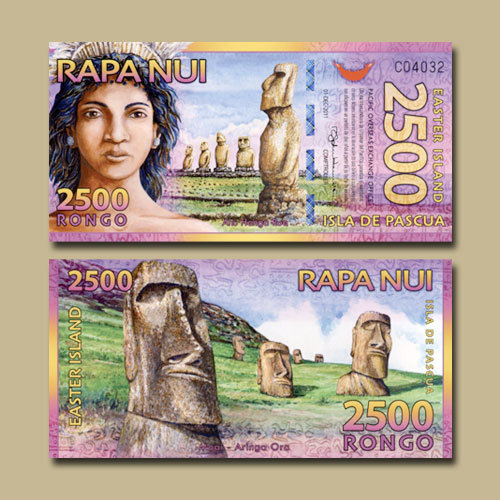Easter Island 2500 Rongo banknote of 2011
2020-01-09 Thu
Easter Island (Rapa Nui: Rapa Nui, Spanish: Isla de Pascua) is a Chilean island in the south eastern Pacific Ocean, at the south-eastern most point of the Polynesian Triangle in Oceania. Easter Island is most famous for its nearly 1,000 extant monumental statues, called Moai, created by the early Rapa Nui people. In 1995, UNESCO named Easter Island a World Heritage Site, with much of the island protected within Rapa Nui National Park.Easter Island is one of the most remote inhabited islands in the world and is considered part of Insular Chile. Today, the island belongs to Chile, hence this country's currency — the Chilean peso — circulates in the Easter Islands. However, the island had issued in 2008 and banknotes in 2012. They were called rongo (the name comes from rongorongo, a form of pictographs used on the island).
Today we are discussing a 2500 Rongo banknote issued in the year 2011. The note specifications are as follows:
The obverse: Portrait of a native woman dancer at Tapati Festival to left; the famous Moai (Easter Island heads) in Ahu Tahai at Hanga Roa to centre; A red Reimiro with human heads on each end - the emblem of the flag of Rapa Nui, to centre right with RongoRongo symbol script in the background.
The reverse: Moai – Aringa Ora - living faces of deified ancestors set in the hillside at Rano Raraku with RongoRongo symbol script in the background. This multi-coloured note has violet, red, yellow, orange and green colours predominantly.
Image Courtesy: Banknote World
Latest News
-
Janma Kalnayak of Bhagwan Mahavir
2024-04-24 WedOn 21st April 2024 which was the 2550th Janma Kalnyanak of Bhagwan Mahavir Swami, PM Modi unveile...
-
Gold Pagoda of Vijaynagar Empire King Deva Raya I
2024-04-10 WedKing Deva Raya I of the Vijayanagara Empire was a patron of Kannada literature and architecture. He ...
-
Silver Denarius of Septimus Severus
2024-04-05 FriLucius Septimius Severus served as the Roman emperor from 193 to 211 AD. Severus sat on the throne o...
-
Extremely rare 'Malaharamari' type Gold Gadyana of King Guhalladeva-III Sold for INR 611000
2024-04-03 WedTribhuvanamalla, also known as Guhalladeva III, was the ruler of the Kadamba dynasty. His reign coin...
-
90 Years of RBI
2024-04-02 TueOn 1st April, PM #Modi unveiled a special commemorative coin marking 90 Years since the foundation o...

